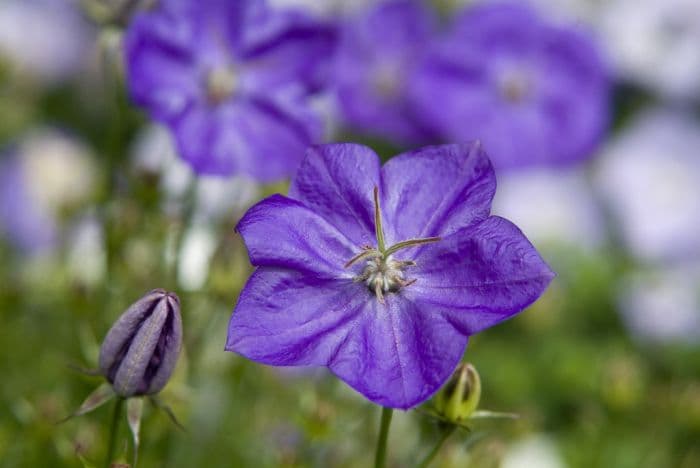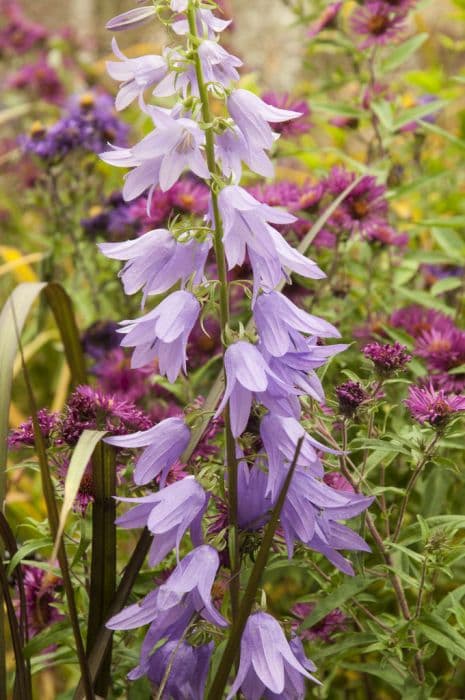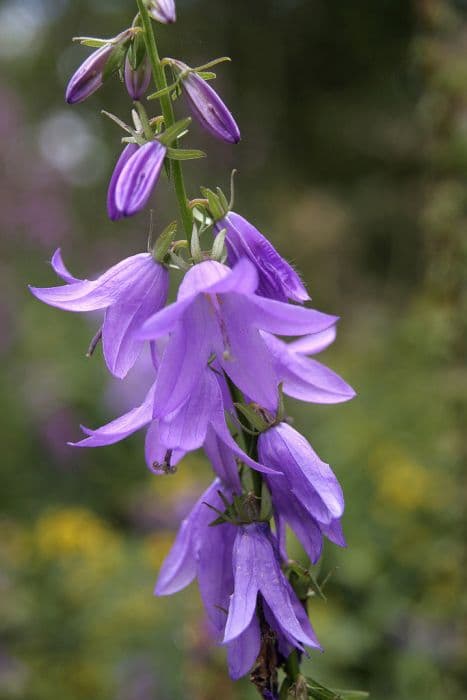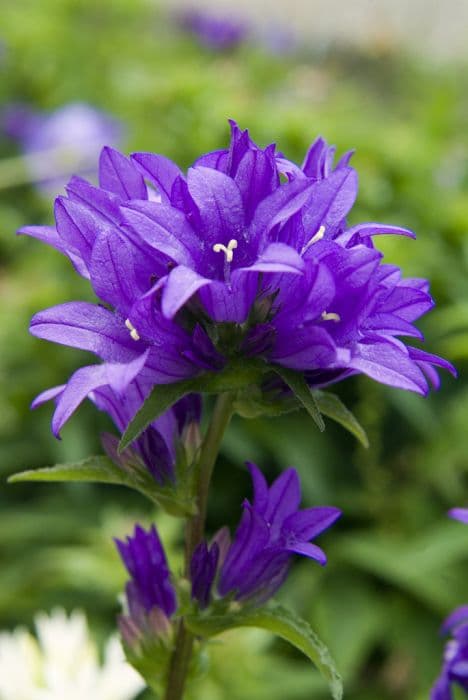Carpathian Bellflower Campanula carpatica var. turbinata 'Isabel'

ABOUT
The Campanula carpatica var. turbinata 'Isabel', commonly known as the Carpathian Bellflower 'Isabel', is a perennial that is known for its beautiful and ornate flowers. The 'Isabel' variety typically features a profusion of blooms that form a low, cushion-shaped mound. Each flower exhibits a bell or cup-shaped appearance, which is characteristic of the Carpathian Bellflower group. Flowers of the 'Isabel' variety have a rich, vibrant color, often a deep purple or blue that can add a striking contrast against the greenery of its foliage. The plant’s leaves are generally heart-shaped or rounded, with a lush, green color that can sometimes exhibit hints of darker shades or lighter undertones. The foliage creates an attractive backdrop for the eye-catching blooms that rise above it on slender stems. Furthermore, the bell-shaped flowers are usually arranged singly on each stem but can sometimes be seen in loose clusters, with each individual bloom facing outwards, eagerly presenting itself for admiration and attracting pollinators like bees and butterflies. The blooms are cherished for their delicate edges and fine structure, which lend a romantic and cottage-garden aesthetic to any setting they are placed in. Overall, the Carpathian Bellflower 'Isabel' is noted for its charming flowers and the elegance they bring to a garden. Its overall form is tightly mounded, maintaining a neat and tidy appearance even when not in bloom. This plant is a popular choice for rock gardens, borders, and alpine gardens, where its compact habit and delightful blossoms can truly shine.
About this plant
 Names
NamesFamily
Campanulaceae
Synonyms
Carpathian Bellflower, Carpathian Harebell, Tussock Bellflower
Common names
Campanula carpatica var. turbinata 'Isabel'.
 Toxicity
ToxicityTo humans
The plant known as Carpathian Bellflower is not commonly listed as toxic to humans. However, it is always advisable to be cautious as individual reactions can vary, and ingestion of any plant material may cause symptoms in sensitive individuals. Normally, if the Carpathian Bellflower is ingested, it is not expected to cause more than mild gastrointestinal discomfort. It is not known to have any severe toxic effects in humans when ingested in typical amounts that might occur accidentally.
To pets
The Carpathian Bellflower is also not known to be toxic to pets. It does not appear on common lists of poisonous plants for animals such as dogs and cats. However, as a general precaution, it is advisable to prevent pets from ingesting plants since individual animals might have sensitivities or allergies. If a pet does ingest some of this plant, it might experience mild gastrointestinal upset, but severe toxicity is not expected.
 Characteristics
CharacteristicsLife cycle
Perennials
Foliage type
Deciduous
Color of leaves
Green
Flower color
Blue
Height
12 inches (30 cm)
Spread
12 inches (30 cm)
Plant type
Herb
Hardiness zones
3
Native area
Europe
Benefits
 General Benefits
General Benefits- Easy to Grow - Campanula carpatica 'Isabel' requires minimal maintenance and can thrive in a variety of conditions which makes it suitable for gardeners of all skill levels.
- Attracts Pollinators - The plant's blooms are inviting to bees, butterflies, and other beneficial insects, fostering a healthy ecosystem in your garden.
- Long Blooming Period - It has a lengthy flowering season, providing color and interest in the garden throughout the spring and summer months.
- Drought Tolerant - Once established, it can tolerate periods of dryness, making it suitable for areas with water restrictions or for xeriscaping.
- Ground Cover - Its low, spreading habit makes it an excellent choice for ground cover, controlling weed growth and preventing soil erosion.
- Decorative Borders - Because of its compact size and pretty flowers, Campanula carpatica 'Isabel' is ideal for creating decorative borders along pathways or garden beds.
- Rock Gardens - Its adaptability to rocky terrains makes it a perfect addition to rock gardens, where it can fill in spaces between stones and add color.
- Container Gardening - This versatile plant is also suitable for container gardening, allowing those with limited space to enjoy its beauty on balconies or patios.
 Medical Properties
Medical PropertiesThis plant is not used for medical purposes.
 Air-purifying Qualities
Air-purifying QualitiesThis plant is not specifically known for air purifying qualities.
 Other Uses
Other Uses- Crafting miniature gardens: Carpathian Bellflower 'Isabel' can be used to create realistic miniature gardens or fairy gardens due to its compact growth habit and attractive flowers.
- Photography prop: The striking blue flowers of the Carpathian Bellflower 'Isabel' make it an excellent photography prop to enhance the composition of garden photography.
- Educational tool: This plant can be grown in school gardens to help teach children about plant growth, pollination, and the lifecycle of perennials.
- Culinary decoration: The flowers of the Carpathian Bellflower 'Isabel' can be used to decorate cakes and pastries, although they are not typically consumed.
- Art inspiration: Artists can use the unique form and color of the Carpathian Bellflower 'Isabel' as a subject or inspiration for paintings, drawings, and other art forms.
- Color dye: Historically, some species of Campanula have been used to make blue dyes; the same could be explored with Carpathian Bellflower 'Isabel' for textile dyeing.
- Bonsai-like displays: Because of its mounded growth, Carpathian Bellflower 'Isabel' could be pruned to resemble a bonsai, making it a unique addition to a bonsai collection.
- Ice cubes: The flowers can be frozen into ice cubes to create an attractive embellishment for specialty drinks or punch bowls at events.
- Theme gardens: This specific variety can be used in "blue-themed" gardens or as part of a color-coordinated landscaping project.
- Seed saving: Enthusiasts of plant propagation may use the seeds of the Carpathian Bellflower 'Isabel' to learn about seed collection, storage, and germination techniques.
Interesting Facts
 Feng Shui
Feng ShuiThe Carpathian Bellflower is not used in Feng Shui practice.
 Zodiac Sign Compitability
Zodiac Sign CompitabilityThe Carpathian Bellflower is not used in astrology practice.
 Plant Symbolism
Plant Symbolism- Affection - Campanula carpatica, commonly known as Carpathian Bellflower, often symbolizes unwavering love and affection due to its bell-shaped flowers that are thought to resemble constancy and everlasting love.
- Gratitude - This plant is also associated with feelings of gratitude. Its blooms are like a gentle reminder to appreciate and acknowledge the beauty in our lives and the kindness around us.
- Constancy - The Carpathian Bellflower represents constancy, perhaps because of its hardy nature and the reliable way it blooms every year, symbolizing steadfastness and resilience in relationships.
- Vulnerability - Despite its sturdy nature, the delicate appearance of the bellflower can convey vulnerability, serving as a symbol for openness and sensitivity in interactions.
 Water
WaterThe Carpathian Bellflower prefers consistent moisture but does not like to be waterlogged, so ensure the soil is well-draining. Water the plant when the top inch of soil feels dry, which typically means watering once or twice a week depending on climate conditions. During hot, dry periods, you might need to water more frequently. Each watering should provide enough water to moisten the soil to a depth of at least several inches; for potted plants, this might translate roughly to about 8-16 ounces, depending on the size of the pot. During winter, reduce watering as the plant's growth slows and it requires less moisture.
 Light
LightCarpathian Bellflowers thrive in full sun to partial shade. The ideal location is a spot that receives at least six hours of sunlight per day. However, in regions with very hot summers, the plants will benefit from some afternoon shade to protect them from the intense heat.
 Temperature
TemperatureCarpathian Bellflowers grow best in temperatures ranging from 60 to 75 degrees Fahrenheit but can tolerate temperatures down from around 50 to highs of about 80 degrees Fahrenheit. Cold hardiness is typically up to -40 degrees Fahrenheit, allowing them to withstand harsh winter conditions. These flowers prefer cooler climates and may struggle in consistently hot temperatures.
 Pruning
PruningPrune Carpathian Bellflowers to remove any dead or damaged foliage and to encourage a compact growth habit. Deadheading, or the removal of spent flowers, promotes the production of new blooms. The best time to prune for shape and to remove the majority of spent flowers is just after the main spring blooming period, but you can deadhead throughout the flowering season as necessary.
 Cleaning
CleaningAs needed
 Soil
SoilCarpathian Bellflower 'Isabel' thrives in well-draining soil enriched with compost or other organic matter. A mixture with equal parts of garden soil, peat, and perlite will ensure good drainage and fertile conditions. This plant prefers a soil pH range from 6.0 to 8.0. You can adjust the pH by adding lime to raise it or sulfur to lower it, according to the current soil condition.
 Repotting
RepottingCarpathian Bellflower 'Isabel' should be repotted every two to three years to replenish the soil and accommodate its growth. It's best to repot in the spring, before the new growth begins. If the plant shows signs of being root-bound or the soil looks depleted, it might be necessary to repot more frequently.
 Humidity & Misting
Humidity & MistingCarpathian Bellflower 'Isabel' tolerates a wide range of humidity levels but prefers moderate conditions. Ideal humidity for this plant would be between 40-60%. Too high humidity can lead to fungal diseases, while very low humidity might stress the plant, so aim to maintain these moderate levels for optimal growth.
 Suitable locations
Suitable locationsIndoor
Provide bright light, well-draining soil, and moderate watering for 'Isabel'.
Outdoor
Plant in partial shade, well-draining soil and water regularly for 'Isabel'.
Hardiness zone
3-9 USDA
 Life cycle
Life cycleCampanula carpatica var. turbinata 'Isabel', commonly known as Carpathian Bellflower 'Isabel', begins its life as a seed, which when sown, germinates in cool temperatures typically in spring. The seedlings emerge and grow into a low, mound-forming perennial, with spoon-shaped leaves forming a basal rosette. As the plant matures, it develops flowering stems, standing above the foliage, bearing bell-shaped, deep blue to purple flowers usually in early to late summer. After pollination, usually by bees and other insects, the flowers produce seed capsules, which when mature, release seeds to initiate the next generation. During autumn, the plant may die back, entering a period of dormancy over winter, but the root system remains alive. In the following spring, the bellflower re-sprouts from the rootstock, completing its life cycle and ready to grow and bloom again.
 Propogation
PropogationPropogation time
Spring-Early Summer
Campanula carpatica var. turbinata 'Isabel', commonly known as 'Isabel' Carpathian Bellflower, is most popularly propagated through seed sowing. This method is typically performed in the spring after the threat of frost has passed, ensuring a safe environment for seed germination. To propagate by seed, one would scatter the seeds on top of a well-draining soil mix in a flat or a container, barely covering them with soil. The soil should be kept moist but not waterlogged, and the container should be placed in a warm, bright area without direct sunlight, which can thwart germination. Germination usually occurs within two to three weeks. After seedlings have developed true leaves and reached a suitable size, they can be transplanted to their final location in the garden or into individual pots. This simple process aids in maintaining genetic diversity within the garden and can provide a large number of plants for landscaping with minimal effort.








